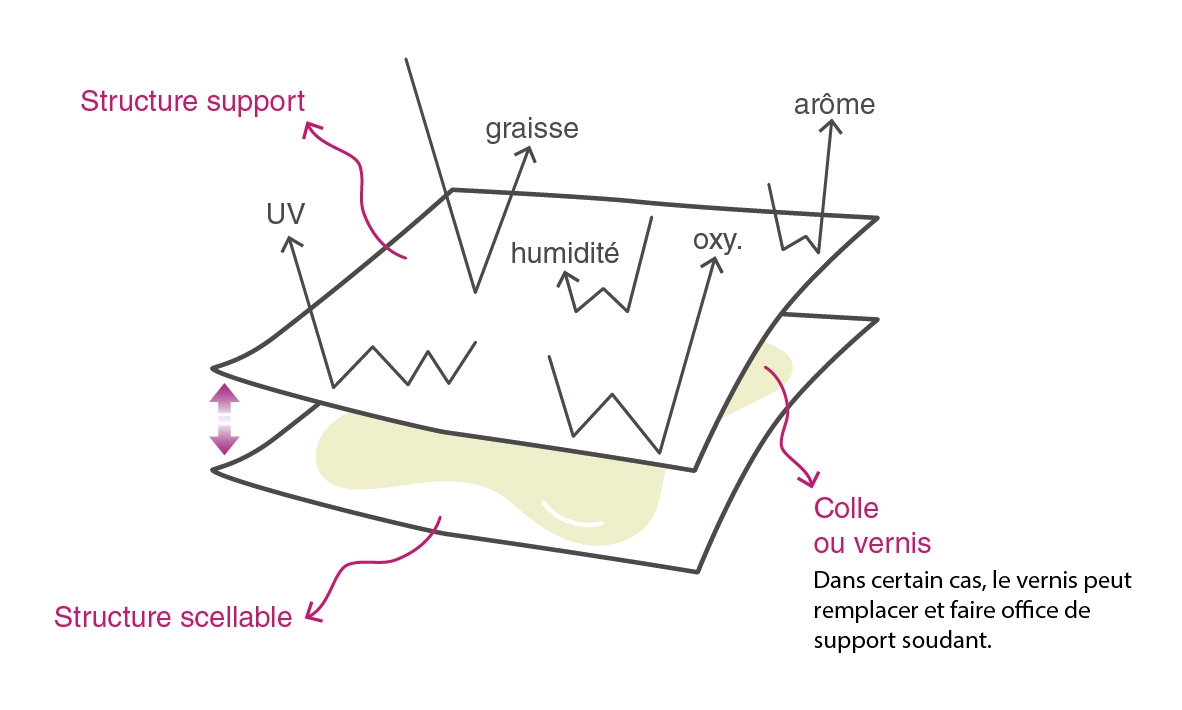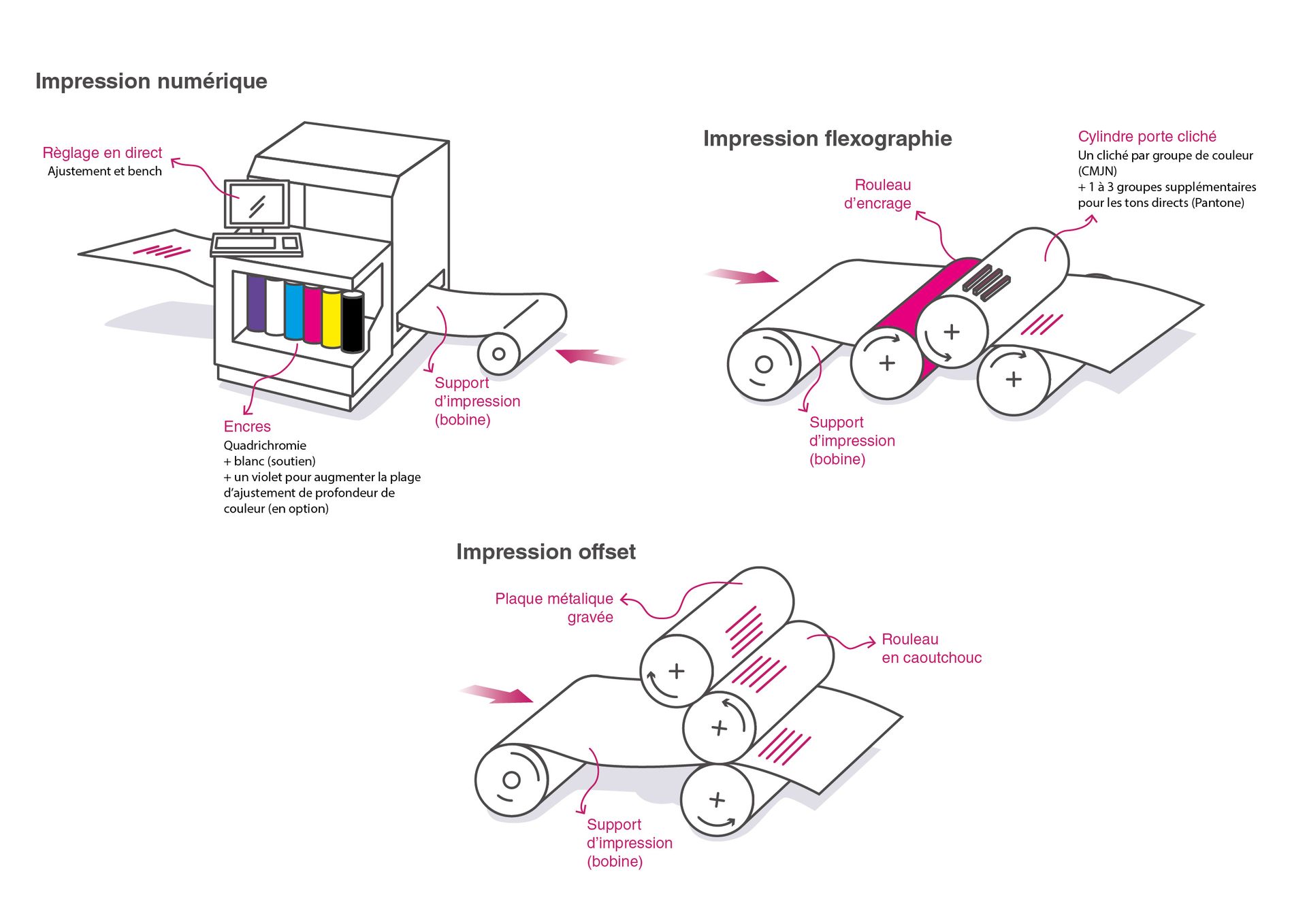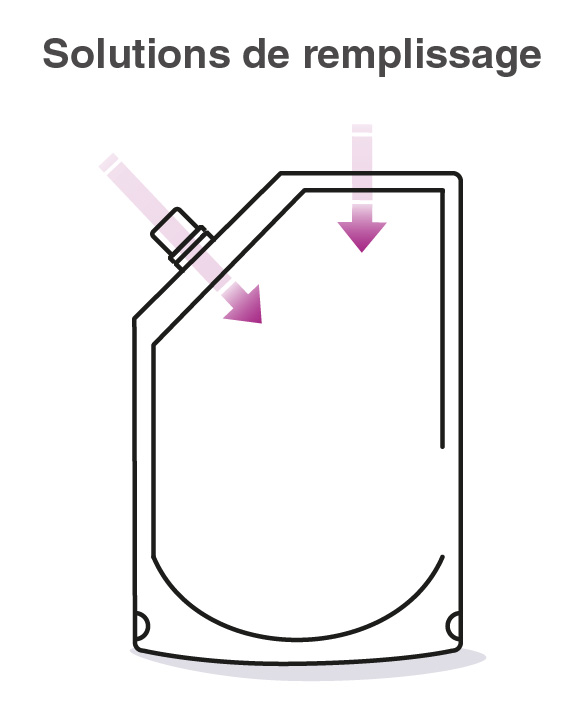Packaging, from film to flexible
Whether it's made from recycled cardboard or polymer film, in stand-up pouches or Berlingots, flexible packaging can be adapted to all sectors and uses. It is material-efficient, preserves product quality, and meets all your needs. But do you know how flexible packaging is made? What is it made of? What sealing and printing techniques are available today? In this article, we take you through all the steps involved in making flexible packaging!
The structure of flexible packaging
Flexible packaging, by definition, is malleable packaging that adapts to the product to be preserved. It is distinguished from rigid packaging by the thickness of the material and its rate of deformation
Its primary objective is to protect the product against the test of time while using as little material as possible. In the design phase, the structure of the flexible packaging is first defined, and varies mainly according to the content and its shelf life. A liquid cosmetic product (e.g., shampoo) will not be stored in the same packaging as a food product (e.g., coffee).

In terms of structure, flexible packaging is a membrane that is more or less impermeable to aromas, gases, humidity, etc. It is therefore usually made up of several layers of film, joined together by additional adhesive materials. Each of these layers of film has a specific function (permeability, printability, etc.).
These include:
⦁ The carrier film: this withstands all mechanical and thermal stresses, must accommodate visual elements, and may have so-called barrier properties (e.g., resistance to gas, oxygen, humidity, grease, aromas, UV, to avoid altering the products) ;
⦁ The sealing film: this is combined with the carrier film to ensure the seal is watertight and resistant in packaging machines. Other films require special sealing techniques, depending on the products used :
⦁ Peelable film: this is often laminated with polymer and barrier films (e.g., yoghurt lids). ;
⦁ Perforated film: this is used for specific applications, such as Camembert cheese packaging.
Laminating
To combine two films with different properties, it is possible to use the laminating technique. This is a way of joining two films using an adhesive which can be wax-based, solvent-free, wet or dry. A special machine called a laminator is used. Laminating is widely used in the flexible packaging industry, particularly in the following cases :
- ⦁ Bonding a transparent polymer film to a printing film to protect the ink ;
- ⦁ Bonding aluminium foil (high barrier properties) to a layer of paper for food preservation ;
- ⦁ Bonding a non-woven (textile) film to another material to create an absorbent hygiene article.
Printing on flexible packaging

Printing is carried out on the packaging film provided. There are various techniques and a whole range of options for personalising the look of your flexible packaging. Here are the main processes :
- Digital printing: inkjet or laser, this high-quality process has the advantage of operating in continuous flow. It requires no tools and offers a wide range of printing options. However, this method is still fairly expensive, which is why it is preferable to use it for small print production batches or for multi-reference ranges ;
- Offset printing: fast and reliable, this is the most widespread technique in the world. It is based on a water repulsion process and transfers the ink onto the packaging film using metal and rubber rollers. Although it does not allow the design to be changed during the process, it is nevertheless very suitable for large production batches ;
- Flexographic printing: similar to offset printing, flexographic printing uses a large-scale printer which reproduces the image on the packaging film using a cylinder or a polymer plate known as a cliché. The cost of this process is very low, but the quality of the reproduction can vary according to the resolution of the machine ;
- ⦁ Heliogravure printing: unlike offset printing, Heliogravure reproduces a visual using hollow cylinders rather than relief cylinders. The image rendition is exceptional. This printing technique is particularly economical for very large production batches.
Flexible packaging finishing
Shaping refers to all operations involved in shaping the flexible packaging, especially film sealing and cutting. The type of assembly and the machine to be used depend on the packaging to be produced. There are two families of packaging machines
- ⦁ Machines that shape and fill the packaging in-line (e.g., for the production of bag of crisps or sugar sticks)
- ⦁ Machines that only perform the shaping operation
(See drawing below: Source https://karlville.com/ )
The shaping machines can be used to produce flexible packaging that can be fully customised or based on standard formats, such as :
- Stand-up pouches ;
- Three-seam pouches, sealed on three sides ;
- Cushion pouches, sealed on all four sides ;
- Berlingot pouches, with a tetrahedral shape.

Filling
To package your liquid, pasty and dry products, you can find all sorts of packaging machines on the market for semi-automatic in-house filling. You can outsource this service to packaging companies (for small or large quantities), with technology adapted to the products they are used to packaging.
Many parameters need to be considered, such as the nature of the container, and the composition of the pouch: its dimensions, the type of opening (nozzle, resealable pouch, etc.), the seals to be applied to the films, etc. Filling is generally the second-to-last step, after which the packaging is closed using the chosen method (spout, seal, etc.).

Now you know everything there is to know about the manufacture of flexible packaging, from structural design to filling !
Do you have a project involving the packaging of products ?
Don't hesitate to work with a packaging solution expert who can find the right packaging solution for you ! un expert de la solution packaging pour trouver l’emballage qui vous convient !